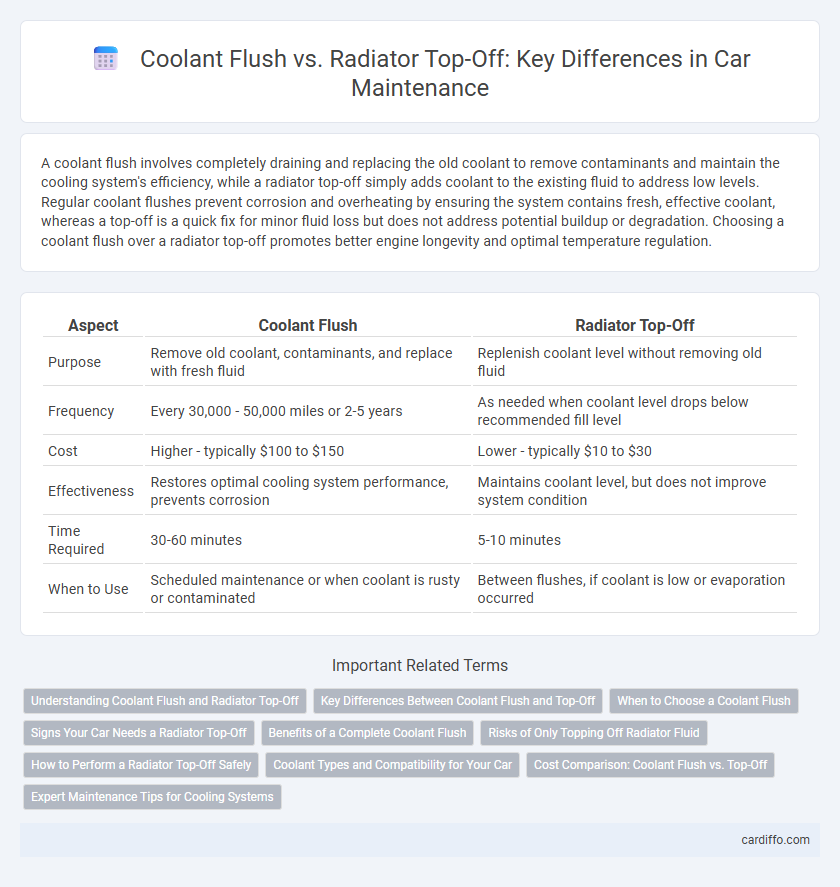A coolant flush involves completely draining and replacing the old coolant to remove contaminants and maintain the cooling system's efficiency, while a radiator top-off simply adds coolant to the existing fluid to address low levels. Regular coolant flushes prevent corrosion and overheating by ensuring the system contains fresh, effective coolant, whereas a top-off is a quick fix for minor fluid loss but does not address potential buildup or degradation. Choosing a coolant flush over a radiator top-off promotes better engine longevity and optimal temperature regulation.
Table of Comparison
| Aspect | Coolant Flush | Radiator Top-Off |
|---|---|---|
| Purpose | Remove old coolant, contaminants, and replace with fresh fluid | Replenish coolant level without removing old fluid |
| Frequency | Every 30,000 - 50,000 miles or 2-5 years | As needed when coolant level drops below recommended fill level |
| Cost | Higher - typically $100 to $150 | Lower - typically $10 to $30 |
| Effectiveness | Restores optimal cooling system performance, prevents corrosion | Maintains coolant level, but does not improve system condition |
| Time Required | 30-60 minutes | 5-10 minutes |
| When to Use | Scheduled maintenance or when coolant is rusty or contaminated | Between flushes, if coolant is low or evaporation occurred |
Understanding Coolant Flush and Radiator Top-Off
A coolant flush involves completely draining and replacing the old antifreeze to remove contaminants, sediment, and rust buildup, which helps maintain optimal engine temperature and prevents corrosion. Radiator top-off simply replenishes the coolant level without removing old fluid, providing a temporary solution to low coolant but not addressing potential system contamination. Understanding the difference is crucial for ensuring engine longevity and preventing overheating by choosing the appropriate maintenance procedure based on the coolant's condition.
Key Differences Between Coolant Flush and Top-Off
Coolant flush involves completely draining and replacing the old coolant to remove contaminants and prevent corrosion, while radiator top-off simply adds coolant to maintain proper fluid levels without addressing old coolant condition. Flushes enhance cooling system efficiency by restoring optimal thermal conductivity and protecting against overheating, whereas top-offs are quick fixes for low coolant levels due to leaks or evaporation. Choosing between the two depends on the vehicle's maintenance schedule and coolant health, with flushes generally recommended every 30,000 to 50,000 miles for long-term system reliability.
When to Choose a Coolant Flush
A coolant flush is necessary when the coolant is contaminated, discolored, or has not been changed for over 2 to 5 years or 30,000 to 50,000 miles, depending on the vehicle manufacturer's recommendations. Signs like overheating, coolant odor, or visible sludge inside the radiator indicate that a coolant flush will restore optimal engine temperature regulation and prevent corrosion. Radiator top-offs only replace lost fluid without addressing underlying contamination or buildup that a thorough flush effectively removes.
Signs Your Car Needs a Radiator Top-Off
Low coolant levels, frequent engine overheating, and visible coolant leaks around the radiator indicate the need for a radiator top-off. Diminished heater performance and warning lights on the dashboard, such as the temperature gauge rising, also signal coolant depletion. Addressing these signs promptly prevents engine damage and maintains optimal cooling system efficiency.
Benefits of a Complete Coolant Flush
A complete coolant flush thoroughly removes old, contaminated coolant and debris, preventing corrosion and buildup in the cooling system that a simple radiator top-off cannot address. This process enhances engine temperature regulation, reduces the risk of overheating, and extends the lifespan of the radiator, water pump, and hoses. Regular coolant flushes ensure optimal coolant performance and protect the engine from costly damage caused by sludge and mineral deposits.
Risks of Only Topping Off Radiator Fluid
Only topping off radiator fluid can lead to coolant contamination and reduced heat dissipation, increasing the risk of engine overheating and potential damage. Over time, debris and rust accumulate in the coolant, which a simple top-off does not remove, causing corrosion in the radiator and cooling system components. Regular coolant flushes are essential to maintain optimal engine temperature and extend the lifespan of the radiator and other cooling system parts.
How to Perform a Radiator Top-Off Safely
To perform a radiator top-off safely, ensure the engine is completely cool before removing the radiator cap to avoid burns from hot coolant or steam. Use a 50/50 mixture of antifreeze and distilled water, carefully pouring it into the radiator until the fluid reaches the recommended fill line. After topping off, securely replace the radiator cap and check for leaks by running the engine briefly while monitoring the coolant level.
Coolant Types and Compatibility for Your Car
Choosing the right coolant type is essential for an effective coolant flush, as incompatible fluids can cause corrosion and engine damage. Radiators often require specific coolant formulas--such as ethylene glycol-based or hybrid organic acid technology (HOAT)--that match the manufacturer's specifications to maintain optimal performance. Always consult your vehicle's manual to ensure compatibility between the coolant type used during a flush and the radiator's requirements, preventing costly repairs and ensuring efficient engine cooling.
Cost Comparison: Coolant Flush vs. Top-Off
A coolant flush typically costs between $100 and $150, involving complete removal and replacement of old coolant to prevent corrosion and overheating. Radiator top-off is significantly cheaper, ranging from $20 to $40, as it only replenishes the coolant level without addressing potential contamination or degradation. While top-offs reduce immediate expenses, a full flush provides better long-term engine protection and can save money on costly repairs.
Expert Maintenance Tips for Cooling Systems
A coolant flush removes old antifreeze and contaminants, restoring optimal thermal efficiency and preventing corrosion, while a radiator top-off merely replenishes coolant levels without addressing sediment buildup. Experts recommend performing a coolant flush every 30,000 miles or as specified in the vehicle's maintenance manual to ensure the cooling system operates effectively and to extend radiator and engine lifespan. Neglecting a flush can lead to overheating, reduced engine performance, and costly repairs due to clogged or damaged cooling components.
Coolant flush vs radiator top-off Infographic

 cardiffo.com
cardiffo.com